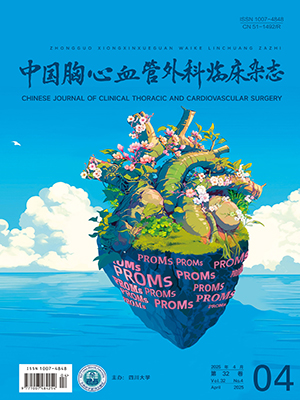Objective
To analyze the curative effect of nitric oxide (NO) and bosentan on treatment of the interruption of aortic arch (IAA) with ventricular septal defect (VSD) and serious pulmonary hypertension (SPH).
Methods
Thirty-two children with IAA and VSD combined SPH from January 2015 to May 2017 confirmed by cardiac CT and ultrasound in Children’s Hospital of Hebei Province were enrolled including 17 males and 15 females, aged 1.10-4.30 months (mean, 2.71±0.98 months) and weighing 3.33-6.10 kg (mean, 4.57±0.88 kg). The 32 children were randomly divided into two groups (n=16 in each), a NO group and a bosentan group. All the patients underwent interruption of aortic arch and ventricular septal defect repair. When patients returned to cardiosurgery intensive care unit (CSICU) half an hour later, patients in the NO group inhaled NO 20 ppm for 36 h and those in the bosentan group were given bosentan by nasogastric feeding 15 mg, twice a day. The cardic index, pulmonary/systemic pressure ratio, oxygenation index at 3 h, 6 h, 12 h, 24 h, 36 h after surgery were evaluated, and the differences between the two groups were compared.
Results
The pulmonary/systemic pressure ratio in the two groups increased at first and then decreased, while oxygenation index in the two groups decreased at first and then increased, and the differences in the same groups at the adjacent time points were statistically significant (P<0.05). The cardiac index in the two groups decreased at first and then increased, the differences in the same groups at the adjacent time points were statistically significant, except for 6 h and 12 h after surgery in the bosentan group (P>0.05). At postoperative 6 h, 12 h, the oxygenation index in the NO group was significantly higher than that in the bosentan group, and the pulmonary/systemic pressure ratio in the NO group was less than that in the bosentan group (P<0.01). The cardiac index in the NO group was higher than that of the bosentan group after 6 h, 12 h, 24 h of operation, which were statistically significant (P<0.05), and the cardic index of children in the NO group was greatly higher than that in the bosentan group after 12 h of surgery (P<0.01); at the same time point, the corresponding indexes were not statistically significant between the two groups (P>0.05).
Conclusion
NO inhalation in the treatment of IAA with VSD and SPH in children with early postoperative SPH is better than the bosentan, but in the late postoperative period, the effect is similar.
Citation:
SONG Hailong, TAO Shuguang, YANG Shihai, WEN Linlin, JIN Lichen, WANG Jianming. Curative effect of nitric oxide and bosentan on treatment of the interruption of aortic arch with ventricular septal defect and serious pulmonary hypertension: A randomized controlled study. Chinese Journal of Clinical Thoracic and Cardiovascular Surgery, 2018, 25(10): 839-843. doi: 10.7507/1007-4848.201710030
Copy
Copyright © the editorial department of Chinese Journal of Clinical Thoracic and Cardiovascular Surgery of West China Medical Publisher. All rights reserved
| 1. |
Jonas RA. Management of interrupted aortic arch. Semin Thorac Cardiovasc Surg, 2015, 27(2): 177-188.
|
| 2. |
黄亚军, 胡志伟, 董念国, 等. 端侧吻合与人工血管矫治婴儿主动脉弓离断早、中期疗效比较. 临床外科杂志, 2017, 25(5): 352-355.
|
| 3. |
EK Ozer, AB Iskit. Effects of endothelin and nitric oxide on cardiac muscle functions in experimental septic shock model. Hum Exp Toxicol, 2016, 35(3): 267-275.
|
| 4. |
Lakshminrusimha S, Mathew B, Leach CL. Pharmacologic strategies in neonatal pulmonary hypertension other than nitric oxide. Semin Perinatol, 2016, 40(3): 160-173.
|
| 5. |
李霞, 李守军, 王旭, 等. 吸入一氧化氮联合西地那非治疗全腔静脉肺动脉连接术后早期肺动脉高压临床安全性的观察. 心肺血管病杂志, 2015, 34(11): 825-829.
|
| 6. |
Milger K, Felix JF, Voswinckel R, et al. Sildenafil versus nitric oxide for acute vasodilator testing in pulmonary arterial hypertension. Pulm Circ, 2015, 5(2): 305-312.
|
| 7. |
朱兴旺, 朱小冰. 吸入一氧化氮治疗新生儿持续性肺动脉高压研究进展. 中国新生儿杂志, 2015, 30(3): 236-240.
|
| 8. |
张玉振, 李玉峰, 赵宏俊. 波生坦片联合西地那非治疗儿童左向右分流型先天性心脏病术后残留肺动脉高压 31 例临床评价. 中国药业, 2015, 24(5): 14-15.
|
| 9. |
Abman SH, Hansmann G, Archer SL, et al. Pediatric pulmonary hypertension: guidelines from the American Heart Association and American Thoracic Society. Circulation, 2015, 132(21): 2037-2099.
|
| 10. |
Lakshminrusimha S, Konduri GG, Steinhorn RH. Considerations in the management of hypoxemic respiratory failure and persistent pulmonary hypertension in term and late preterm neonates. J Perinatol, 2016, 36(Suppl 2): S12-S19.
|
| 11. |
戴海龙, 鲁一兵, 光雪峰, 等. 波生坦在先天性心脏病合并肺动脉高压患者中的应用进展. 中国循环杂志, 2016, 31(2): 206-208.
|
| 12. |
Voerman JS, Remerie S, Westendorp T, et al. Effects of a guided Internet-delivered self-help intervention for adolescents with chronic pain. J Pain, 2015, 15(11): 1115-1126.
|
| 13. |
王丽, 汪佩, 李岩鹏, 等. 17β- 雌二醇和 2- 甲氧基雌二醇对慢性低氧性肺动脉高压大鼠体内内皮素-1/一氧化氮体系的影响. 中国循环杂志, 2016, 31(5): 489-494.
|
| 14. |
Steinhorn RH, Kusic-Pajic A, Cornelisse P, et al. Bosentan as adjunctive therapy for persistent pulmonary hypertension of the newborn: results of the randomized multicenter placebo-controlled exploratory trial. J Pediatr, 2016, 177: 90-96.
|
- 1. Jonas RA. Management of interrupted aortic arch. Semin Thorac Cardiovasc Surg, 2015, 27(2): 177-188.
- 2. 黄亚军, 胡志伟, 董念国, 等. 端侧吻合与人工血管矫治婴儿主动脉弓离断早、中期疗效比较. 临床外科杂志, 2017, 25(5): 352-355.
- 3. EK Ozer, AB Iskit. Effects of endothelin and nitric oxide on cardiac muscle functions in experimental septic shock model. Hum Exp Toxicol, 2016, 35(3): 267-275.
- 4. Lakshminrusimha S, Mathew B, Leach CL. Pharmacologic strategies in neonatal pulmonary hypertension other than nitric oxide. Semin Perinatol, 2016, 40(3): 160-173.
- 5. 李霞, 李守军, 王旭, 等. 吸入一氧化氮联合西地那非治疗全腔静脉肺动脉连接术后早期肺动脉高压临床安全性的观察. 心肺血管病杂志, 2015, 34(11): 825-829.
- 6. Milger K, Felix JF, Voswinckel R, et al. Sildenafil versus nitric oxide for acute vasodilator testing in pulmonary arterial hypertension. Pulm Circ, 2015, 5(2): 305-312.
- 7. 朱兴旺, 朱小冰. 吸入一氧化氮治疗新生儿持续性肺动脉高压研究进展. 中国新生儿杂志, 2015, 30(3): 236-240.
- 8. 张玉振, 李玉峰, 赵宏俊. 波生坦片联合西地那非治疗儿童左向右分流型先天性心脏病术后残留肺动脉高压 31 例临床评价. 中国药业, 2015, 24(5): 14-15.
- 9. Abman SH, Hansmann G, Archer SL, et al. Pediatric pulmonary hypertension: guidelines from the American Heart Association and American Thoracic Society. Circulation, 2015, 132(21): 2037-2099.
- 10. Lakshminrusimha S, Konduri GG, Steinhorn RH. Considerations in the management of hypoxemic respiratory failure and persistent pulmonary hypertension in term and late preterm neonates. J Perinatol, 2016, 36(Suppl 2): S12-S19.
- 11. 戴海龙, 鲁一兵, 光雪峰, 等. 波生坦在先天性心脏病合并肺动脉高压患者中的应用进展. 中国循环杂志, 2016, 31(2): 206-208.
- 12. Voerman JS, Remerie S, Westendorp T, et al. Effects of a guided Internet-delivered self-help intervention for adolescents with chronic pain. J Pain, 2015, 15(11): 1115-1126.
- 13. 王丽, 汪佩, 李岩鹏, 等. 17β- 雌二醇和 2- 甲氧基雌二醇对慢性低氧性肺动脉高压大鼠体内内皮素-1/一氧化氮体系的影响. 中国循环杂志, 2016, 31(5): 489-494.
- 14. Steinhorn RH, Kusic-Pajic A, Cornelisse P, et al. Bosentan as adjunctive therapy for persistent pulmonary hypertension of the newborn: results of the randomized multicenter placebo-controlled exploratory trial. J Pediatr, 2016, 177: 90-96.




